Lydia Bell and daughter Havana, embark on a single-parent adventure and discover why now is the time to visit Egypt
In the dusky beauty of the afternoon our entourage of mothers and children board a felucca, the limpid Nile turning Aswan’s ochre sands and shaggy palms into a watercolour that we gaze into as its glides along. Two boys paddle up on planks of wood looking for baksheesh, regaling us with multi-lingual medleys that segue from ‘Frère Jacques’ into ‘football’s coming home’. Decanting on the west bank we climb onto textile-festooned camels for a sublime trek past the roofless basilica of the seventh-century Monastery of Saint Simeon, finishing at sunset as the muezzin echoes from the minarets and the stars arrive to serenade the evening
When the chance came to join a trip through Egypt with other mums and their children ranging from five-14 years, I jumped on the chance to take my seven-year-old daughter. It is with Intrepid Travel, an Australia-based small-group adventure outfit that has evolved since I took a trip across Mongolia with them in my twenties in a Russian camper van. This is their latest invention to satiate the adventure starved parenting masses: solo-parent trips to Morocco, India, Costa Rica, Vietnam and Thailand. You don’t have to be a single parent, though most are. Intrepid aren’t alone in doing this, but it’s going well – 70 per cent of ‘solo’ trips are booked up, and they are tripling the departures next year.
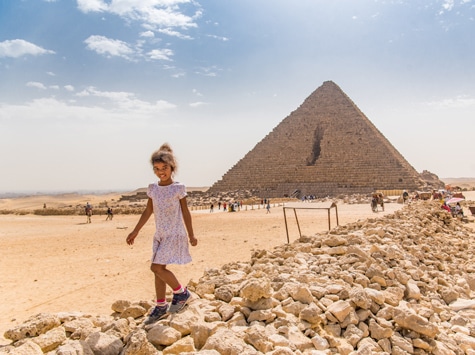
Havana at the pyramids of Giza
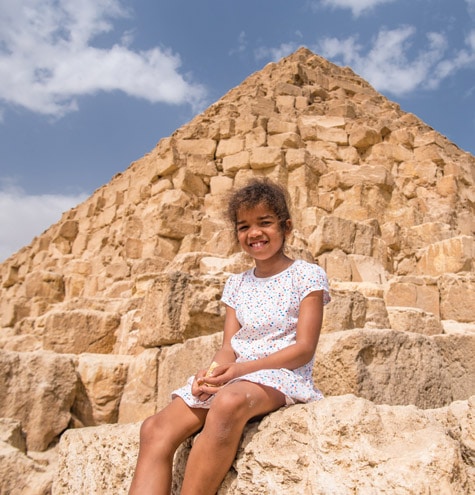
Havana at the pyramids of Giza
‘Who so hath not seen Cairo hath not seen the world,’ proclaimed The Arabian Nights, and so we start here, in one of the Islamic world’s greatest city, making a bee line for the pyramids of Giza. Wildly beautiful from a distance, jaggedly impressive up front, and deeply atmospheric inside, they do not disappoint. My daughter Havana and I fold into a pretzel shape and join the line flowing into the interior of the Great Pyramid of Cheops. Is it booby-trapped she demands? Are you sure this is a burial chamber? (I decide against telling her our friend Rama believes the pyramids were built by Martians to create electricity.) We shuffle up into the dark, airless, oven-warm space, sensing the claustrophobia of the crowd. What is unfathomable about the pyramids is the sheer antiquity. Egyptians started building pyramids from the 27th century BC. This whippersnapper was finished about 2,560 years before Christ, the jewel in the crown of Phaoronic civilisation.
In downtown Cairo, our heads spin in the Egyptian Museum. Founded in 1858, it retains a Victorian sensibility with its sweeping staircases, vast halls and rooms full of overlooked antiquities. It is so overstuffed that a new museum will open in Giza next year. The best bits are the gold mask of Tutankhamen – 11kg of solid, pristine, unmarred gold. And the Royal Mummies Hall: a collection of royal human relics that blow the socks off. The children are blasé, even though the mummies of Ramses I, Seti I, his son Ramses the Great, Merenpath, Ramses III and others remain so human they might sit up and talk. The rest of this city of 20 million passes in a hawking, dusty, hazy blur of frenetic, colour-bleached streets. We rush to our overnight train, and the children settle excitedly into sleeper bunks.
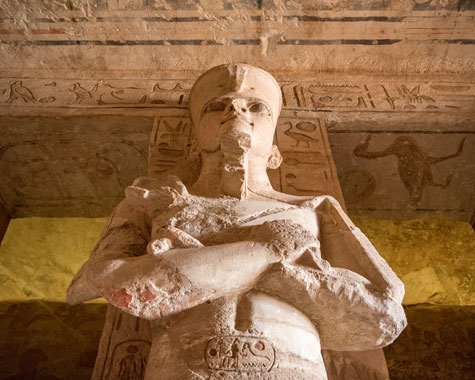
Sun temple of Ramses II at Abu Simbel
In Aswan, we come into our own. Set on the Tropic of Cancer, Egypt’s most southerly outpost retains that air of romance captured by Agatha Christie when she wrote Death On The Nile holed up in the Old Cataract Hotel. In ancient times, Aswan was the gateway to the kingdom of Nubia; today it remains a cultural frontier between the Middle East and Africa. If Luxor has staggering ancient relics, Aswan is a lovely place to be. The children meld into a gaggle by the pool of our unadorned, river-set hotel.
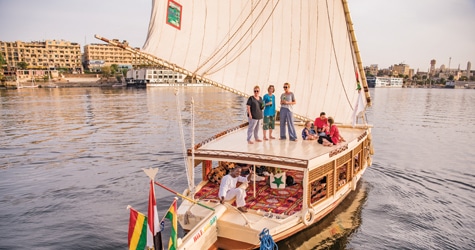
Felucca on Nile at Aswan
We use Aswan as a jumping-off point to the temples of Philae and Abu Simbel. The former is nearby, close to the great dams beyond the First Cataract. At the Shallal docks we take a ferry to Philae in the First Cataract, a lush stretch of river divided into channels by rocky outcrops. The damming of Lake Nasser between 1958 and 1970 meant this monument had to be decanted to a new position. You can’t tell. The cult of Isis may be no more, but the temple’s timeless beauty and elegance remains potent.
One night a Nubian family on Elephantine Island, which squats beautifully in the middle of the river, prepare for us a vegetarian feast. As ever, the children are the conduit to our shared humanity, running and playing, kicking balls, joining in when the Egyptian children sing and dance with their tambourine. Another night, in the souq, they are enticed with toys and mini galabiyyas, the adults with saffron, spices, teas, basketry and molasses. Nubian ladies tattoo their arms with spidery flourishes of henna. We take a 45-minute jaunt in a plane near the Sudanese border to the Sun Temple of Ramses II at Abu Simbel built by Ramses II. Its monumental façade has four colossal statues of Ramses carved out of the rock. I’ll never forget it.
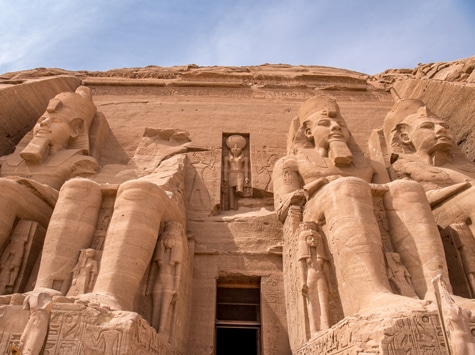
Abu Simbel
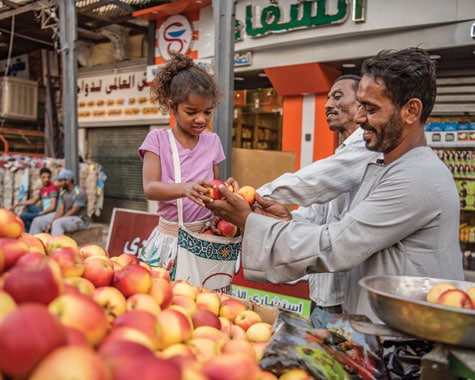
Havana buys apples for the group at market in Aswan
Our last stop, Luxor, is a five-hour drive. Dharou City is revving up for its Tuesday camel and water buffalo fair. Men lounge in coffee shops in blue abayas and white turbans communing over hubble-bubbles. Covered women sell pigeons, cauliflower and cabbages roadside. Trucks of camels, bulls and donkeys rumble to market. Our guide, Walid, patient, positive, beloved of the children (a father to two sets of twins) does not rest, interspersing card games with interjections on the pillars of Islam and a reasonable price for a donkey and a bull (12,000 Egyptian pounds, ‘depending on his size’, and 20-25,000 Egyptian pounds respectively). It’s down to him that we manage to cover so many sites with such young children; he engages them with tales of ancient deities, reenactments and childish games.
We pass en route by Kom Ombo, a Hellenic-era temple dedicated to two gods: Horus the elder and the crocodile headed Sobek, the Egyptian god of the Nile. He points out the hieroglyphics depicting the three ancient seasons (harvest, winter, summer), and the list of offerings permissible to the gods, and the gargantuan mummified giant Nile crocodiles in the museum. With its Pompeii-like Karnak temple, and its Valley of the Kings, where the burial site of the boy-king, Tutankhamen, was rediscovered by British archaeologist Howard Carter in 1922, Luxor was the cradle of Pharaonic civilisation when its 1000 BC dynasty ranged from South Sudan to Syria. The west bank is a network of sarcophagi, a zone of death, but the children are pragmatic, accepting and curious of that fact.
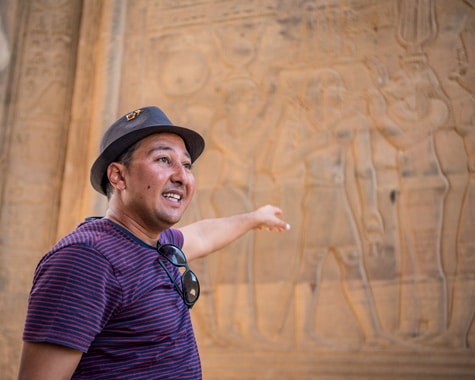
Walid at work
Tourism to Egypt is on the up. Family bookings last year were up 390 per cent for Intrepid, with a 117 per cent increase in visitors from the UK. While over-tourism can mar the feel of being in a place, Egypt, for now, offers the opposite experience. If the Arab Spring crushed the livelihood of many, it made the Egyptian touristic experience temporarily more exclusive. The moment crystallised when we found ourselves alone in a passage in the great temple at Abu Simbel. We lingered alone, calmly meditating on the mystery of these exquisite, up-lit hieroglyphics. They were for that moment ours, and ours alone.

Our group at the end of a camel trek as the sun sets on the West Bank of the Nile at Aswan
Intrepid Travel offers a nine-day ‘Egypt Family Holiday for solo parents’ trip.
Prices start at £745 per person and include eight nights’ accommodation with breakfast, some other meals, transport and most activities.